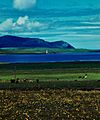Hoy facts for kids
Hoy is a large and beautiful island in the Orkney Islands of Scotland. It is the second-largest island in the Orkney group. The name "Hoy" comes from the Old Norse word Háey, which means "high island," a perfect description because of its tall cliffs and hills.
Contents
Exploring Hoy's Landscape
Hoy is famous for its dramatic and varied landscape. Unlike many flatter Orkney islands, Hoy has rugged hills and impressive sea cliffs.
The Old Man of Hoy
One of the most famous landmarks on Hoy is the Old Man of Hoy. This is a tall, thin stack of sandstone rock that stands proudly out of the sea. It's about 137 metres (449 feet) high and is a popular spot for climbers and visitors. It's amazing to see how the ocean has carved this unique shape over thousands of years.
Hoy's Mountains and Valleys
The island has several hills, including Ward Hill, which is the highest point in the Orkney Islands, reaching 479 metres (1,572 feet). There are also deep, green valleys like the Rackwick Valley, which is known for its peaceful beauty and traditional croft houses.
Wildlife and Nature on Hoy
Hoy is a very important place for nature and is protected as a Site of Special Scientific Interest (SSSI). It's also part of a National Scenic Area because of its outstanding natural beauty.
Birds of Hoy
The cliffs of Hoy are home to thousands of seabirds. You can see many different species, especially during the spring and summer nesting season. Some of the birds that live here include kittiwakes, guillemots, razorbills, and puffins. It's an amazing sight to watch them flying around the tall cliffs. The Royal Society for the Protection of Birds (RSPB) has a nature reserve on Hoy to protect these important bird colonies.
Plants and Animals
Beyond the birds, Hoy also has unique plants that thrive in its moorland and coastal areas. You might spot red deer roaming the hills, and if you're lucky, you could see seals or even whales in the waters around the island.
Hoy's History and Culture
Hoy has a rich history, with evidence of human activity stretching back thousands of years.
Ancient Sites
One of the most mysterious ancient sites on Hoy is the Dwarfie Stane. This is a large block of sandstone that has been hollowed out to form a small chamber, like a tiny house. No one is entirely sure who made it or why, but it's thought to be a Neolithic tomb or a hermit's dwelling. It's a fascinating puzzle from the past.
Wartime History
During both the First World War and the Second World War, Hoy played an important role because of its location near Scapa Flow. Scapa Flow was a major naval base for the Royal Navy. You can still see reminders of this history, including gun batteries and defensive structures. The Lyness Royal Naval Cemetery is a peaceful place where many service members who died during the wars are buried. The Scapa Flow Visitor Centre tells the story of this important naval history.
Life on Hoy Today
Today, Hoy is home to a small community of people. Life on the island is quiet and connected to nature. Many visitors come to Hoy to enjoy its walking trails, stunning scenery, and rich wildlife. It's a perfect place for anyone who loves the outdoors and wants to explore a unique part of Scotland.
Images for kids
-
Cliffs on the Atlantic coast of Hoy, south of Rackwick









